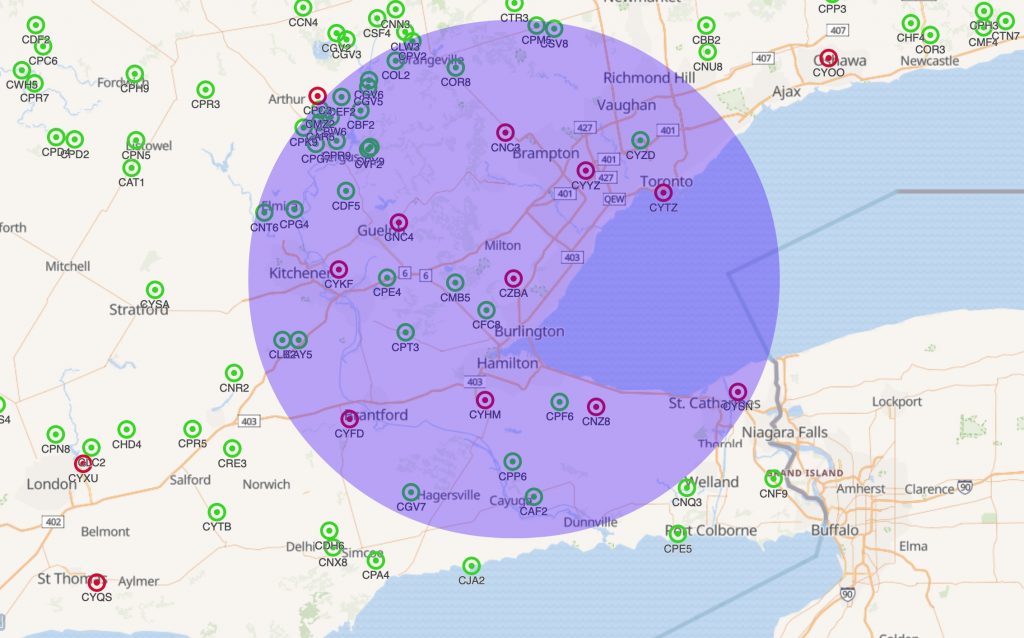FAQ
Content
- CIFIB Association
- What is Canadian In-Flight Information Broadcasting Association?
- Why would we want to set up a ground station?
- What is required to set up a ground station?
- How much will a ground station cost?
- What about liability?
- Will I have any control over how CIFIB operates?
- Can I support CIFIB without committing to a ground station?
- CIFIB Network
CIFIB Association
What is Canadian In-Flight Information Broadcasting Association?
The Canadian In-Flight Information Broadcasting Association (CIFIB) is a not-for-profit company that aims to improve the safety of General Aviation aircraft, pilots, and passengers through the provision of In-Flight Information Broadcasting, including Canadian aviation weather and traffic information. CIFIB is operated as a public service. There is no cost to a pilot to use the system, though an aircraft must have an ADS-B system capable of receiving the data, and a suitable display. These systems are available today at decreasing costs.
For a five-minute introduction to CIFIB, watch the YouTube video: https://youtu.be/mhoUgmfRyp8
Why would we want to set up a ground station?
The CIFIB service should reduce aviation accidents such as mid-air collisions and weather-related accidents. A reduction in accidents will save lives and reduce injuries. A site providing CIFIB services will improve safety in the area, which can attract pilots and increase airport revenues (fuel, restaurant, use of other airport and community services). FBOs would be able to provide more services (fuel, repairs, parking, others). Flight training programs could make use of CIFIB information as part of training.
What is required to set up a ground station?
A local organization or group applies to CIFIB and agrees to fund the installation and operation of the site. A suitable and secure location, with power and Internet connection, is identified and any necessary approvals received. A qualified installer is contracted to install the hardware. Once the site is operational, local involvement will be minimal.
How much will a ground station cost?
A basic CIFIB installation costs $2000 plus applicable taxes. This one-time fee covers acquisition, a basic installation, setup, and configuration of the ground station. For a basic installation, a licensed contractor mounts the CIFIB transmitter on an existing pole or tower, or mounts a small pole to an easily accessible structure. More complex installations, such as those involving significant heights or requiring detailed analysis and mitigation for nearby equipment or structures, may incur additional costs.
An annual subscription fee covers the data stream, operation, and insurance. The subscription fee is also $2000 per year plus applicable taxes. As more stations are added, this cost is expected to decline for each site.
As a not-for-profit company, CIFIB Association will regularly review costs, and lower fees will be passed on to sites.
What about liability?
CIFIB Association owns the hardware and operates the site. CIFIB provides liability insurance for the equipment and the transmission of the services, which is included as part of the annual fee paid to CIFIB. Installation and any servicing of the equipment must be done by properly bonded agents who will provide liability protection for their work.
Will I have any control over how CIFIB operates?
A site can nominate one person to become a member of CIFIB Association. The member is able to attend meetings and receive CIFIB communications. CIFIB welcomes and considers all feedback to guide future operations.
Can I support CIFIB without committing to a ground station?
Yes! You can support CIFIB financially by making a donation. All fees and donations are used to set up and operate the CIFIB network. You can also support CIFIB by encouraging groups to set up a ground station in their area.
We are also looking for volunteers to continue to development of the network. If you have RF engineering skills or software development skills and are interested in helping us on a volunteer basis, contact us at info@cifib.ca.
CIFIB Network
What information will a CIFIB ground station provide?
Ground stations broadcast local and regional weather information, including weather radar (from Environment Canada), METARs, TAFs, and some private weather station information.
Ground stations may broadcast area traffic information, including FLARM and OGN (gliders), and NemoScout (flight school aircraft).
In future, CIFIB broadcasts may include NOTAMs, lightning, cloud tops, freezing/icing level, upper winds and temperatures aloft, PIREPs, AIRMETs, SIGMETs, turbulence, MOS, and weather from ASOS/AWOS/LWIS. ATC radar traffic is also being considered.
What is the range of a site?
The transmission and reception of CIFIB broadcasts operates on line-of-sight. The range of reception varies by aircraft altitude and orientation, intervening obstacles, receiver antenna type and location, and transmitter signal strength. A typical station has a range of 35-50NM for an aircraft operating at 5000′ AGL.

Will Canada have national coverage like the US?
No. With a larger area and 1/10 the population, national coverage is not practical in Canada. CIFIB ground stations will cover areas with higher traffic volumes, prioritizing sites that fill in gaps with more traffic. While there is no upper limit to the number of ground stations, CIFIB expects to eventually operate about 100 ground stations.
Is CIFIB compatible with US ADS-B In?
Yes. CIFIB implements UAT as specified by the FAA. Any ADS-B In receiver compatible with the US network will also receive CIFIB broadcasts. The weather and traffic services provided in Canada and the United States differ, but the hardware used to receive and display the services are the same, allowing cross-border compatibility for Canadian and US pilots and aircraft.